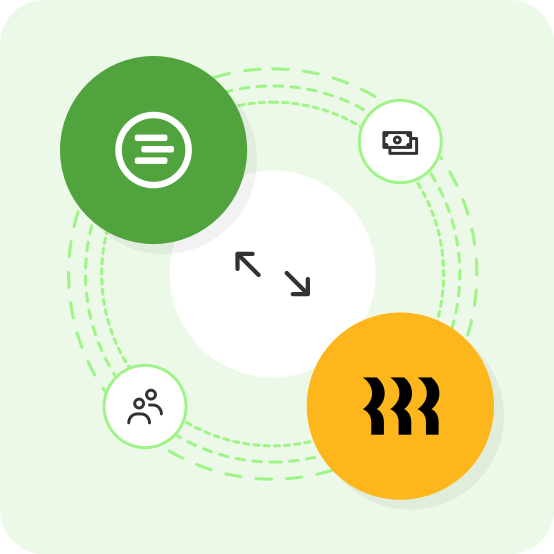What Is Payroll Management?
Try When I Work for free
In this article, you’ll find out about payroll management, why it’s so important to get right, and what the drawbacks are when you get it wrong. Plus, you’ll learn about the three different ways to manage your payroll so you can choose the option that’s right for your business.
Key takeaways
- Employee compensation is about more than just the hours worked, as it also includes PTO, deductions like health care, overtime and commissions, and more.
- Managing payroll isn’t just about being efficient, it’s about accuracy and legal compliance.
- You can choose to manage your payroll yourself manually, but there are other options that can save you a lot of time.
Whether you’re managing payroll for a restaurant or handling the complicated shifts of an emergency worker schedule, payroll management isn’t easy.
Paying each employee what they are owed is the core of your business. Without great payroll management, there won’t be employees. No employees, no business. Payroll management can make or break you—it’s a complicated mix of gross pay, hour calculations, withholding, and taxes.
If payroll management seems to pull together too many important components with no room for error, we have good news for you: managing your payroll has never been easier.
Once you understand what payroll management is and how it should work, it’s easy to choose from the three different methods of accomplishing it (with the third being a life-changer for any payroll manager).
Table of contents:
- What is payroll management?
- How does payroll management work?
- The importance of efficient payroll management
- Payroll management methods
- Common payroll management challenges
- When I Work for payroll management
- Conclusion
What is payroll management?
Payroll management is overseeing and administering all financial aspects of employee compensation.
Employee compensation is more than just paying the wage for the hours worked. It also includes accurately tracking PTO, overtime, withholding, breaks (paid and unpaid), and compliance with all employment laws.
The four most common types of payroll frequencies are:
- Weekly: Employees are paid every week, based around a seven-day period. That comes out to 52 pay periods in a year.
- Bi-Weekly: Employees are paid every two weeks, resulting in 26 pay periods each year.
- Semi-Monthly: Payroll goes out twice a month, usually on specific dates (e.g. 15th and last day of the month). This is fairly common, and leads to 24 pay periods each year.
- Monthly: Employees are paid once a month, usually on a specific date.
Quarterly wages are also an option, though less common than the four listed. Payroll frequency varies depending upon local and state employment laws, internal company policies, employee agreements, and preferences.
Some employees prefer more pay periods, while employers may prefer to reduce payroll frequency to save time on administering it.
How does payroll management work?
Payroll management is something every business that has employees must deal with.
It requires accurate time tracking and employee data. Without it, payroll management is impossible. All applicable employee data is processed to calculate each paycheck for each pay period. Taxes have to be done correctly, and you, the employer, must make sure you’re making the correct payments to government agencies as required or risk serious fines.
At the start, most businesses choose to manage payroll manually because they have fewer employees. This saves on cost as it doesn’t require a third party to help. But even then, because payroll management requires so many different kinds of employment records be pulled together, this is still tricky.
Steps of the payroll management process
The payroll management process is straightforward:
- Gather employee information. This includes SSN or ID numbers, tax withholding forms, and employee classification information. Some cities and states have additional requirements.
- Calculate employee wages. Using work hours, overtime, bonuses, commissions and tips, and other similar factors, employers calculate gross pay.
- Handle deductions. This includes federal, state, and local taxes (income, Social Security, Medicare) and withholdings (e.g. retirement or health insurance contributions).
- Process payroll. At this point, actual processing of payroll begins, involving payment to employees.
- Compliance and records. Maintaining accurate and historical records of payroll processing is required, including tax filings, wages, hours, and anything that shows employers are in compliance with the law.
The importance of efficient payroll management
You can pull together payroll at the last minute and throw a paycheck at employees, or you can take a systematic approach and be efficient when it comes to managing payroll.
Efficiently managing payroll isn’t just about saving time, but accuracy. There are several key issues at stake.
Here are the key benefits to understand about payroll management:
Legal compliance
Consider that about 20 different records have to be kept and maintained to meet federal requirements. That doesn’t include state and local.
Efficient payroll management forces you to track and maintain those records by the nature of the process. Approaching payroll management in a way that is inefficient allows room for error in this critical area. Get legal compliance wrong and you could face big fines.
Employee retention
One of your best employee retention strategies is efficient payroll management.
Your employees place high value on accurate and prompt payment for the hours they’ve worked. It’s one of the main reasons they have a job. Poor payroll management translates into paychecks with errors, late payments, reissued payments, or future adjustments that are frustrating for employees and can even cause financial hardship.
Maintaining records
Keeping track of payouts, transactions, deductions, and tax filings are part of the process of efficiently managing payroll.
This means that you must document everything as you’re managing payroll, and in doing so, you create and maintain records naturally.
Add a payroll integration to save more time! Learn more about our available integrations and see how you can simplify scheduling and payroll for your team.
Payroll management methods
There’s no right or wrong way to manage your payroll as long as you are accurately completing every step of the process. However, some payroll management methods are easier than others. They make it easier to stay efficient and accurate.
Here are the top three methods to consider when it comes to payroll management:
1. Manual spreadsheets
All payroll calculations are done by manually gathering data from appropriate sources and entering them into a spreadsheet.
These sources include time cards or time sheets, as well as up-to-date tax and withholding information from the government. They might also include withholdings that include health insurance, retirement, or health savings accounts.
Ideally, the spreadsheet already has formulas in place to accurately handle taxes and deductions. But even if it does, the challenge with manually calculating payroll in a spreadsheet are:
- The amount of information you must work with
- The time it takes to sift through all the information for each employee
- Inaccuracies in your calculations before it gets into the spreadsheet
- Mistakes in payments that are not easily corrected
Manual processing is often the first step for small businesses due to the lack of cost of hiring someone to manage payroll, but it comes with its own costs in time and error.
2. Outsourced payroll services
Using a payroll service provider is a great way to save time and let the professionals handle the tricky details of payroll compliance.
No more need to manually update employee databases, enter time cards and percentages into spreadsheet cells, or cut checks. The payroll service provider handles it all and most will customize what they provide you based on your specific needs and employee base.
The down-side to outsourcing is that it’s very hands-off as well as being expensive.
Losing touch with how your payroll is going means entrusting everything to the provider while reducing the amount of time you spend looking at important data. It’s when you handle your own payroll data that you can spot issues with overtime or absenteeism. A provider won’t have the same interest in your data beyond accurate payroll calculations.
3. Payroll management software
Using payroll management software to manage your payroll is the best of both worlds. You still have a hands-on approach with your employee data, but the process is automated and doesn’t require so much manual work.
Payroll management software:
- Increases efficiency and saves time
- Increases accuracy and improves compliance
- Makes accessing tax information easy
- Offers direct integration with employee time clock apps to reduce redundancy
- Opens the door to flexible payment options
- Helps keep internal data secure and confidential
- Grows with you as employee numbers increase
- Provides you with reports and useful analytics
The fact that payroll management software can integrate with other software tools you currently use means many of these benefits are spread even further.
You can save even more time when you choose a complete system like When I Work. You’ll get employee scheduling, time tracking, communication, and now payroll processing, all on one platform. There’s no syncing or importing data from one system to another. That means you get everything in that list above, plus the peace of mind knowing that all of your data is stored in one place and automatically updated to keep you compliant.
Common payroll management challenges
Payroll management has a lot of challenges.
- Communication problems, like lost team member messaging that can affect payroll
- Time card issues, such as cards with errors
- Mistaken calculations, such as calculating overtime or paid time off
- Compliance and keeping up with regulations that change often
- Syncing with online employee scheduling to avoid redundancy
The best choice for payroll management
Payroll management can’t go wrong—that’s not an option. It matters too much to your employees and to your financial bottom line. With all of the detail it requires, choosing payroll management software is the best choice.
When I Work integrates seamlessly with payroll providers to save you even more time. Our payroll integrations, especially the one to our preferred partner, Rippling, help you connect scheduling and payroll in one streamlined workflow, so you can focus on running your business, instead of reconciling timesheets.
When I Work preferred payroll partner
Make payroll simple with our preferred partner Rippling, an all-in-one platform for payroll, benefits, and compliance. Together, When I Work and Rippling help you save hours every week while reducing errors, staying compliant, and getting your team paid on time.







